- Joined
- Nov 18, 2015
- Messages
- 73
- Reaction score
- 115
What do seahorses eat? How to feed seahorses in aquariums!
Original post: https://seahorsewhisperer.com/what-do-seahorses-eat/
Simple enough question right? Or could nutrition be one of the reasons that people fail to keep them healthy in captivity?

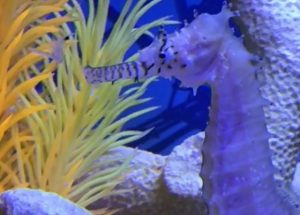 Seahorses might be fish, but they do not have a stomach like other fish, that can hold and digest food, providing nourishment over time. So they need to eat a lot more, and more often to stay healthy. In the ocean, seahorses have their pick of many different crustaceans, eating any small invertebrate or fish in the 1/2″ – 1″ size range. Mysis, amphipods, copepods, baby fish, and basically any organism that can be sucked up their snout becomes food (in my aquariums, the seahorses go wild when peppermint shrimp larvae fill the tank). The smaller the size of the food, the more of them the seahorses will need to eat to stay well nourished. Smaller foods like copepods are a wonderful snack, but a seahorse can eat 3,000 a day and will then spend most of their time foraging through algae to find more food. Trying to provide this amount of live foods in a home aquarium can be very difficult and get extremely expensive to maintain long term. Luckily, captive bred seahorses will be weaned onto frozen foods, making things much easier on a hobbyist.
Seahorses might be fish, but they do not have a stomach like other fish, that can hold and digest food, providing nourishment over time. So they need to eat a lot more, and more often to stay healthy. In the ocean, seahorses have their pick of many different crustaceans, eating any small invertebrate or fish in the 1/2″ – 1″ size range. Mysis, amphipods, copepods, baby fish, and basically any organism that can be sucked up their snout becomes food (in my aquariums, the seahorses go wild when peppermint shrimp larvae fill the tank). The smaller the size of the food, the more of them the seahorses will need to eat to stay well nourished. Smaller foods like copepods are a wonderful snack, but a seahorse can eat 3,000 a day and will then spend most of their time foraging through algae to find more food. Trying to provide this amount of live foods in a home aquarium can be very difficult and get extremely expensive to maintain long term. Luckily, captive bred seahorses will be weaned onto frozen foods, making things much easier on a hobbyist.
HOW DO SEAHORSES EAT?
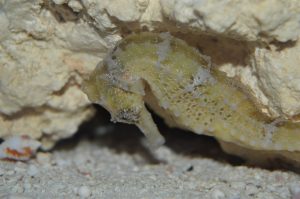
Watching a seahorse eat is fascinating, because they literally suck their food up into their straw shaped snout so quickly it is difficult to see without slow motion. There are many muscles and bones working together in the seahorse’s head to make their vacuum-like action of sucking up food possible, but I will just describe what it looks like to an average observer. The trigger (or hyoid bone) underneath the seahorse’s jaws acts like a sling-shot. The seahorse pulls that trigger downward, expanding his or her gills at the same time. (I’m always amused by this, because they look as if they are about to blow a bubble). Instead, when the trigger is released at the same time as the gills deflate, the vacuum like suction is created, and the food and water in front of the seahorse is pulled into it’s snout. The seahorse swallows the the food whole, and any excess water or bits of food are released through a small opening in their gill chambers, looking like a puff of smoke shooting out of the seahorse’s head. The “snick” sound is made by bones in the seahorse’s head clicking into each other as all of his or her muscles move together to allow the seahorse to eat. To watch seahorses eating in slow motion, click HERE! To hear the “snick” and see the food released from gill chambers click HERE! The stills below show the trigger in action!

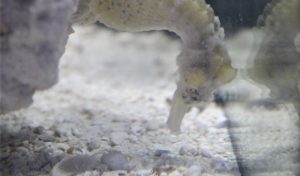
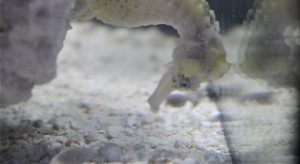
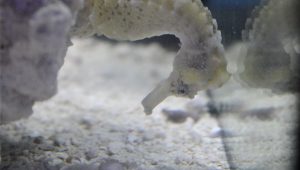
HOW MUCH SHOULD I FEED CB SEAHORSES?
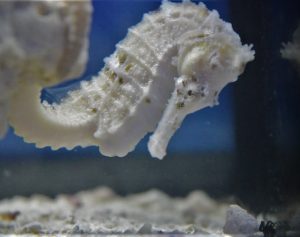 The recommendation is 3-4 feedings a day. The way I determine how much to feed seahorses is by asking them
The recommendation is 3-4 feedings a day. The way I determine how much to feed seahorses is by asking them  . Instead of a scientific calculation to determine how much they need, I feed based on what they will eat each time. For instance, I will feed a new pair of seahorses 1 cube of rinsed mysis. After half an hour, I return to see how much mysis remains uneaten, also checking the filtration system to see how much was sucked up by the filter. The leftovers are removed before they add to the organic levels in the tank. If there were a lot of leftovers, the next feeding I will try 1/2 a cube instead. If there is no mysis left over after the half hour, I add a second cube to the next feeding. I keep adjusting the amount until the seahorses eat all of the food within the half hour. Then I know how much mysis to rinse for each feeding. (*Never thaw frozen foods until they are ready to be used and please read preparation section). Seahorses definitely eat more than typical fish, which is why having an excellent nutrient export system in place is so important to keep organics in check. Suggestions regarding nutrient export equal will be provided in the filtration article coming soon.
. Instead of a scientific calculation to determine how much they need, I feed based on what they will eat each time. For instance, I will feed a new pair of seahorses 1 cube of rinsed mysis. After half an hour, I return to see how much mysis remains uneaten, also checking the filtration system to see how much was sucked up by the filter. The leftovers are removed before they add to the organic levels in the tank. If there were a lot of leftovers, the next feeding I will try 1/2 a cube instead. If there is no mysis left over after the half hour, I add a second cube to the next feeding. I keep adjusting the amount until the seahorses eat all of the food within the half hour. Then I know how much mysis to rinse for each feeding. (*Never thaw frozen foods until they are ready to be used and please read preparation section). Seahorses definitely eat more than typical fish, which is why having an excellent nutrient export system in place is so important to keep organics in check. Suggestions regarding nutrient export equal will be provided in the filtration article coming soon.
HOW CAN I TELL IF MY SEAHORSE ARE GETTING ENOUGH FOOD?
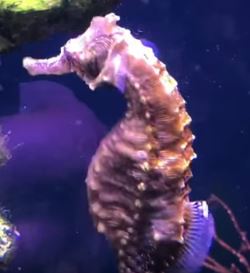
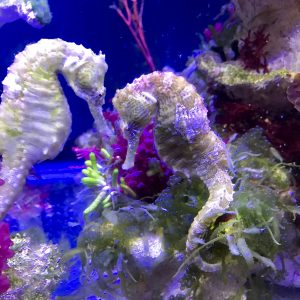 After I decide on an amount to give the seahorses at each feeding, I monitor their weight to make sure they are getting enough to eat. Again, no scientific calcualtions required! I simply watch them to be sure their sides do not begin to look caved in. A female will look starved after an egg exchange, because she loses 1/3 of her body weight when she give a male the eggs. Aside from this instance, a seahorse should never have sides that curve inward. If I notice that my seahorses are beginning to look thin, I feed more in future meals and/or add more random treats.
After I decide on an amount to give the seahorses at each feeding, I monitor their weight to make sure they are getting enough to eat. Again, no scientific calcualtions required! I simply watch them to be sure their sides do not begin to look caved in. A female will look starved after an egg exchange, because she loses 1/3 of her body weight when she give a male the eggs. Aside from this instance, a seahorse should never have sides that curve inward. If I notice that my seahorses are beginning to look thin, I feed more in future meals and/or add more random treats.
When new seahorses have to be delivered, the breeder will often not feed them the day before they are shipped. This is to avoid a lot of fouling in the shipping container, making the water less likely to become ammonia filled. So do not be alarmed if seahorses arrive with sides slightly curved inward. They will fatten up quickly once you get them eating. The idea is to watch their weight over time, because the amount of food seahorses eat will need to be adjusted as they get bigger. If new seahorses have places between their rings that look caved in, that is a much more serious problem and will be addressed in an illness article. Avoid buying a seahorse that has indented places between rings.
HOW CAN I FEED SEAHORSES IF I WORK?
Many people believe they cannot keep seahorses because they work, but there are many ways to work out a good schedule. My feeding schedule goes a little something like this: After I have rushed the children out the door, I rinse enough frozen mysis to feed my many tanks of seahorses. The morning feeding is more of a “Good morning seahorses! We’re running late again, so….enjoy” as I smack the feed button on my RW4s, toss in the right amount of food and move on to the next tank. I throw myself together, and then check each system to be certain the RW4s came back on and nothing is amiss before rushing to work. Hopefully your morning routine will be much more relaxed, but I do make sure their evening meals are more enjoyable.
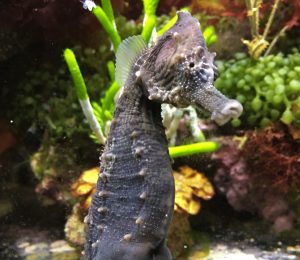 After work, I greet the seahorses and feed all of the tanks before settling down for my own dinner. In this second feeding, I take more time to be certain that all seahorses are eating, and sometimes use a turkey baster to spot feed any seahorse that might be busy analyzing a snail, missing out on food due to the others being pigs. Typically, my seahorses are already stationed at the front of the tank when I get home, and will throw very impatient looks my way if I am 5 minutes behind schedule (this is no joke, seahorses will get used to the schedule and expect food at the appropriate times). Feedings become an excellent time to enjoy watching the seahorses and determine if any seahorse is having an issue, or anything is amiss with the system.
After work, I greet the seahorses and feed all of the tanks before settling down for my own dinner. In this second feeding, I take more time to be certain that all seahorses are eating, and sometimes use a turkey baster to spot feed any seahorse that might be busy analyzing a snail, missing out on food due to the others being pigs. Typically, my seahorses are already stationed at the front of the tank when I get home, and will throw very impatient looks my way if I am 5 minutes behind schedule (this is no joke, seahorses will get used to the schedule and expect food at the appropriate times). Feedings become an excellent time to enjoy watching the seahorses and determine if any seahorse is having an issue, or anything is amiss with the system.
The third feeding happens right before I go to bed. I time this so that they have at least half an hour to move around after the final feeding, before the lights go out for the night. This is just personal preference, but my seahorses are quite chubby and need all the “exercise” they can get!
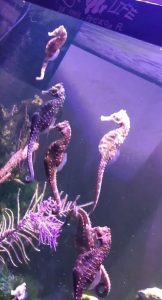
Variety will be discussed further down in the article, but in order to provide more nutrition to my seahorses, I give them a fourth feeding of enriched live foods. This is optional, but I am quite convinced it makes a huge difference in keeping seahorses healthy. Sometimes I will order in live mysis shrimp from Sach’s. Other times I will order artemia from Live Brine Shrimp.com or Brine Shrimp Direct, to be enriched with probiotics or vitamins. Finally, approximately once a week I harvest copepods from my culture and feed those to the seahorses. My largest hippocampus erectus will barely look at the copepods because they are so small. But, I do see them snick at seemingly nothing from time to time, and the pods help clean the tank. Live feeds should always be extremely clean to avoid adding any bad bacteria to the tank, and enriching them will provide even more nutrition.
WHICH FOODS SHOULD I FEED MY SEAHORSES?

Frozen mysis is the choice food of most seahorse keepers and breeders. The first reason is that seahorses recognize mysis shrimp as a food. Trying to get seahorses to eat pellets or flakes is difficult, because even captive born seahorses will be used to eating foods that look like crustaceans….not hard balls of dried food. One of my Hippocampus Reidi will only eat frozen shrimp that still have their heads and eyeballs attached. As long as she eats, I am happy. But, she would starve before snicking up something that did not resemble a live crustacean. Most seahorses won’t be this picky, but frozen version of foods they recognize as dinner will be more likely eaten.
The second reason is that marine fish need to eat food that are high in HUFAs (highly saturated fatty acids), especially DHA and EPA. Mysis shrimp have higher levels of these fatty acids than some of the other options. In the ocean, all of the zooplankton that seahorses eat are full of the phytoplankton (or microalgae) that they themselves fed upon. The microalgae is the base of the marine food chain, because it contains the HUFAs and other nutrients that marine fish require to stay healthy. Basically, the seahorses get extra nutrition from marine algae by eating the crustaceans that just ate the algae! Mysis shrimp themselves just have a better nutritional profile, plus they provide additional nutrition by eating smaller zooplankton that have fed on the good phytoplankton.
If seahorses are fed something like artemia (brine shrimp), they will not get those long-chain polyunsaturated fatty acids from their food, or at least not in the right ratios. A good comparison would be feeding a human child nothing but bread. There are many good (and bad) things that bread provides, but there are too many other nutrients that a child needs to grow healthy and strong. Choosing a peanut butter sandwich instead will provide the child with more protein and good fats from the peanuts. Even better would be to feed many different foods, and add a vitamin in the morning to provide any needed nutrients that the food did not contain. We can give seahorses a varied diet and vitamins too by adding other frozen foods and enriched live foods as treats in addition to the mysis meals!
WHY CAN’T I JUST FEED MY SEAHORSES BRINE SHRIMP?
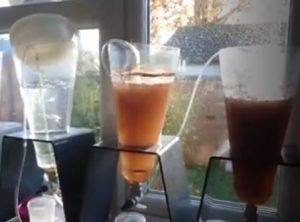
Well, you can….but they will not live for very long without some other food source. Seahorses provided only artemia will start getting weak, become more susceptible to illnesses and eventually starve due to the lack of nutrition. Brine shrimp are technically marine, but they do not come from the same places in the ocean as the seahorses, nor the typical seahorse foods (nor THEIR foods). This means that collected adults will not have the same make up nutritionally as other feeds, and will not contains those fatty acids that seahorses need to stay healthy.
The nutritional composition of artemia was reviewed at different stages in the book “Live Feeds in Marine Aquaculture“. The findings suggest that newly hatched artemia provide vitamins and protein, but won’t have high DHA levels because their yolk sac is based on the parents’ nutritional composition. When the artemia begin eating for themselves, scientists figured out that they retroconvert DHA into EPA quickly. This means that even enriched artemia must be fed to seahorses at precisely the right time in order to provide proper nutrition, or be enriched with a blend that takes this into consideration and has high DHA to EPA ratios. You can read more about artemia by clicking on the link, but the important thing to understand is that seahorses have nutritional needs that brine shrimp alone cannot fulfill. Seahorses love to eat them, but the artemia will not be enough to sustain seahorses long-term without enrichment via a blend high in lipids, containing the proper ratios of each fatty acid, immediately before feeding. Brine shrimp can make a great snack, just not the main course.
There are many frozen brands that boast enriched frozen brine shrimp, which will be better than the brine shrimp alone. However, without knowing exactly which enrichment product was used or how soon the brine shrimp were frozen after enrichment, there is no guarantee that the seahorses will actually get all of the nutrition promised. In my opinion, it is a much better idea to feed frozen mysis as the main course for seahorses, and use brine shrimp(frozen or live) and live foods such as copepods as additional treats.
HOW DOES ENRICHMENT WORK?
Enrichment means to “make something better”. In this case, an organism like brine shrimp is soaked in or fed a blend of phytoplankton (which contains the HUFAs that seahorses need), vitamins and other nutrients to make them more nutritious. Once the brine shrimp are enriched with the things that seahorses need from their foods, they are like a big vitamin!
 Any filter feeding organism like artemia can be used as a vessel to get nutrition, medication and basically anything you want to get into seahorses. When they are fed an enrichment like DAN’s FEED, all of the nutrition in the blend are consumed or stick to the sides of the brine shrimps’ bodies. The seahorses then benefit from the enrichment by eating the brine shrimp. Dans’ Feed is a “well balanced nutrional blend of amino acids, vitamins, minerals, proteins, and Omega 3 fatty acids with a very high DHA to EPA ratio”. In some blends like DANs FEED WITH PROBIOTICS, even probiotics are passed onto the seahorses when they eat the brine shrimp. The brine shrimp can also be fed to larger feeds like live mysis, that the seahorses might enjoy a bit more.
Any filter feeding organism like artemia can be used as a vessel to get nutrition, medication and basically anything you want to get into seahorses. When they are fed an enrichment like DAN’s FEED, all of the nutrition in the blend are consumed or stick to the sides of the brine shrimps’ bodies. The seahorses then benefit from the enrichment by eating the brine shrimp. Dans’ Feed is a “well balanced nutrional blend of amino acids, vitamins, minerals, proteins, and Omega 3 fatty acids with a very high DHA to EPA ratio”. In some blends like DANs FEED WITH PROBIOTICS, even probiotics are passed onto the seahorses when they eat the brine shrimp. The brine shrimp can also be fed to larger feeds like live mysis, that the seahorses might enjoy a bit more.
There are a couple of things to remember, such as the amount of time the artemia need to be enriched and how quickly the brine shrimp need to be fed to the seahorses so that they still contain the enrichment blend in proper ratios. Also that live foods can bring a contaminant or pathogen to the tank, so the hatchery, enrichment vessels and etc must stay extremely clean, and the artemia must be thoroughly cleaned themselves before being fed to the seahorses. These questions will be answered in detail in the live feeds article that is almost finished. The point to understand is that brine shrimp are not nutritious enough to be the only food provided to seahorses and must be enriched to do the seahorses any good.
WHICH ENRICHMENT FORMULA OR BLEND IS THE BEST?
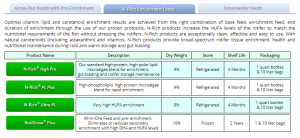
There are also different enrichment formulas and blends of phytoplankton (and different zooplankton for that matter) that can provide different nutritional benefits to seahorses. Feeding seahorses does not have to become complicated, but if you are interested in culturing or learning about the different ways that specific feeds can target specific nutritional benefits, Reed Mariculture provides a wealth of information on their website. The company offers an extensive line of different growout and enrichment options to boost the nutrition of almost any live feed. This particular company is land based and offers clean cultures that have not been exposed to pathogens in the ocean. The company’s website does a great job of explaining the different nutritional profiles and which benefits each different microalgae blend offers. Click HERE to read my article and interview with the company’s live feeds supervisor, Chad Clayton, or HERE to visit their site. If you want to provide your seahorses with these benefits without having to understand all of the science, Chad (or another company representative) will happily explain your options and point you in the right direction based on your needs.
Frozen foods can also be enriched with products like vita-chem, vibrance and other liquid vitamins. The foods are soaked in the enrichment before being fed to the seahorses. The only problem I have with this method is that so much of it comes off of the food as soon as the food hits the water. Also, the moment a frozen food is thawed, it begins losing quality and spoiling. Most of the “soaks” for foods require soaking the foods in the vitamins for many minutes before feeding, which would mean the food itself was degrading at the same time. I do not personally use the soak type of enrichments, but I wanted to include that these options exist.
WILL SEAHORSES REVERT BACK TO WANTING ALL LIVE FOODS IF I GIVE ENRICHED TREATS?
This question prevented me from feeding my seahorses live foods for way too long. My fears were ridiculous and unwarranted.
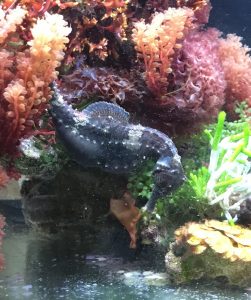

First of all, it is extremely unlikely that any saltwater tank will remain void of copepods and other small critters long-term. Who would want it to? The small critters play other important roles in supporting the eco-system and….. they are free seahorse food. But, the chances of small organisms like copepods entering an aquarium as hitchhikers are so great that trying to keep them out is not possible. Therefore, the seahorses will already have live food options.
Second, a captive bred seahorse will have been trained to eat frozen foods at a very young age, and not have any times of only eating live foods to “revert back to“. Quality breeders provide growing seahorses with frozen foods AND enriched treats, so they will already be used to eating both. This might be more of a concern with a wild caught seahorse, but I hope that anyone reading this article will have either purchased captive bred seahorses, or be a professional with more experience and options to deal with any problems such as this.
Finally, In my opinion, the benefits of providing enrichment and variety in the diet outweighs any risk of a seahorse demanding live foods.
WHY IS PROVIDING VARIETY IN THE DIET IMPORTANT?
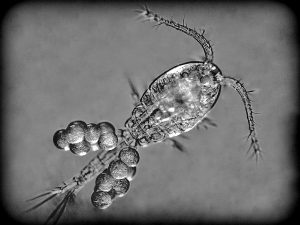 Seahorses eat many different foods in the wild, so providing variety in seahorses’ diets allows them to eat as they would naturally, while still making sure they get the nutrition required to stay healthy. Hunting live treats also provides mental stimulation that they will not get as much of in an aquarium. Feeding frozen mysis shrimp at least three times daily fulfills the basic nutritional needs of a seahorse, but adding enriched live feeds and other frozen foods is like icing on the cake. Who doesn’t like cake? However, before you give up on keeping seahorses because providing them variety seems like too much work, remember that there are many ways to provide variety. If you are not interested in culturing and/or enriching live treats, variety in the diet can be provided via other frozen foods or purchasing live foods, but skipping the enrichment process. Different organisms have different nutritional profiles, and each have something different to offer the seahorses. As long as mysis is provided as the main course, and the seahorses’ basic nutritional needs are fulfilled, treats are just a bonus…..(like I said, cake)!
Seahorses eat many different foods in the wild, so providing variety in seahorses’ diets allows them to eat as they would naturally, while still making sure they get the nutrition required to stay healthy. Hunting live treats also provides mental stimulation that they will not get as much of in an aquarium. Feeding frozen mysis shrimp at least three times daily fulfills the basic nutritional needs of a seahorse, but adding enriched live feeds and other frozen foods is like icing on the cake. Who doesn’t like cake? However, before you give up on keeping seahorses because providing them variety seems like too much work, remember that there are many ways to provide variety. If you are not interested in culturing and/or enriching live treats, variety in the diet can be provided via other frozen foods or purchasing live foods, but skipping the enrichment process. Different organisms have different nutritional profiles, and each have something different to offer the seahorses. As long as mysis is provided as the main course, and the seahorses’ basic nutritional needs are fulfilled, treats are just a bonus…..(like I said, cake)!
Some other frozen foods that can be added to provide variety include: cyclops-eze, krill, gammarus, enriched brine shrimp, and my seahorses eat Rod’s Pacific Plankton as if it’s…..well, CAKE! Live foods include: copepods, amphipods, mysis, ghost or glass shrimp, brine shrimp, and rotifers for fry.
SEAHORSE FOOD PREPARATION
WHICH BRAND OF FROZEN MYSIS IS BEST?
The brand is completely based on preference and availability, but all frozen foods are not equal. Reading the packaging can tell you which species of mysis is frozen, the process the company uses to freeze the food, and whether or not they use any fillers. Also important is whether the mysis is whole and intact. The species used is important because they can be very different sizes, and come from different environments (marine versus freshwater). For instance, PE Mysis contains Mysis Relicta, a freshwater Mysidae that resembles a shrimp, but will not carry any marine parasites. According to the company, “the Canadian lake Mysis Shrimp are enriched in high lipid content, long chain fatty acids, and are rich in Omega 3 and 6, amino acids and powerful antioxidants” naturally. The company flash freezes the mysis to preserve quality, also freezing the nutritional plankton inside them, making them naturally enriched.

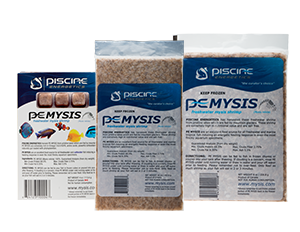 Hikari have two brands of mysis, but both are put through a 3 stage sterilization process, and then enriched with multiple nutrients and fatty acids before being frozen. The company points out that they use “whole mysis, enrich the food versus the water and process with a mega-powered freezer”. I personally like both of these brands, along with a few others, and will use both to feed at different times. The Hikari mysis are smaller and easier for younger seahorses to eat, and it takes fewer PE Mysis to fill up my larger adults. There are pros and cons to each brand, and changing between brands gives seahorses the benefits from each.
Hikari have two brands of mysis, but both are put through a 3 stage sterilization process, and then enriched with multiple nutrients and fatty acids before being frozen. The company points out that they use “whole mysis, enrich the food versus the water and process with a mega-powered freezer”. I personally like both of these brands, along with a few others, and will use both to feed at different times. The Hikari mysis are smaller and easier for younger seahorses to eat, and it takes fewer PE Mysis to fill up my larger adults. There are pros and cons to each brand, and changing between brands gives seahorses the benefits from each.
The amount and type of fillers, along with whether the whole mysis is used are important because a seahorse tank is already a battle with organics. As discussed earlier in the article, seahorses need to eat more often than other fish and turn their food into waste more quickly. They also release little bits of food in that “puff of smoke” that seems to come out of their gills as they suck the food down. Those little bits of food, any uneaten leftovers and the waste that it all turns quickly into can make a seahorse tank get dirty very quickly. Any binders, fillers or small pieces of broken up mysis will merely add to the organic levels in the tank. Choosing brands that use plant based binders and whole mysis helps a keeper avoid even more bits build up in the tank due to the heavy feedings seahorses require.
WHY DOES THE COLOR OF FROZEN FOOD MATTER?
If mysis shrimp is brown, do not buy it! If mysis looks more brown than white in color, this is a clear sign that the food has been refrozen, contaminated or in some way has gone bad. Tami Weiss of Fusedjaw.com wrote two excellent articles covering the importance of choosing foods that have not been thawed multiple times, going into detail about the dangers of feeding frozen foods that have been refrozen. You can read the articles HERE, and part 2 HERE. The quality degradation and harmful bacteria that are able to contaminate the foods each time they are thawed should be avoided at all cost. Some ways to avoid bad frozen foods include:
Freezing seafood slows down the break down of quality and growth of bad bacteria. However, the moment frozen food begins to thaw, any bacteria that was on the food prior to freezing begin to multiply. The longer the food sits out, the faster harmful bacteria can grow. Lipids and other nutrients that you want the seahorses to gain from eating the food also begin to break down at a very fast rate. We do not thaw seafood we plan to eat for dinner on the counter (or if you do…..stop it!), and frozen fish foods need the exact same considerations. One way to safely thaw frozen mysis is to put the amount you intend to use in the refrigerator, inside a cup of chilled tank water. This allows the food to thaw slowly so it does not lose quality, and the refrigerated temperatures stop bad bacteria from taking over.
I am really bad with time management and often realize that I forgot to refrigerate food for the seahorses’ next feeding. In these situations, rinsing the mysis in a brine shrimp net by running cold water over it is better than letting the food thaw at room temperature. Rinsing the food can clean it of preservatives, additives and many unwanted little bits, but it also destroys quality somewhat. The “cool water” needs to keep the food below the temperature “danger zone” (between 40 – 140 degrees Fahrenheit), which can be difficult to determine without pulling out a thermometer. But, rinsing is always better than letting the food sit out on a counter. In these cases, just use very cool water, and feed immediately after rinsing. Frozen fish food above all else is seafood, so prepare it is if you were going to eat it yourself!
HOW SHOULD I FEED THE THAWED FROZEN FOOD TO SEAHORSES?
There are a few different methods seahorse keepers use to feed:
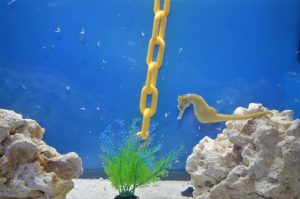
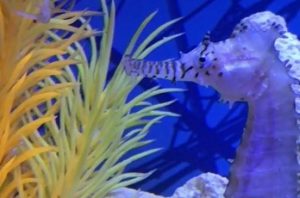
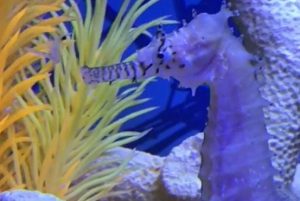


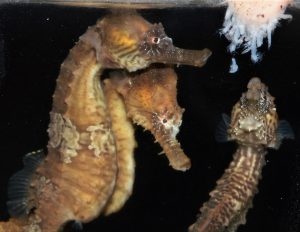
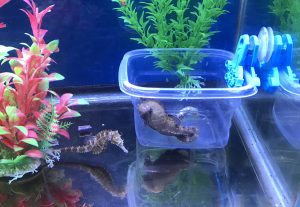
CONCLUSION
Providing the right foods and proper nutrition to seahorses should be a keepers most important goal, but it does not need to become an overwhelming task. There are many different ways to add nutrition to a seahorse’s diet, and doing things differently is not always wrong. My most difficult obstacle in writing these articles is trying to accommodate keepers at different places in their seahorse experience. The larger species (excluding dwarfs) of captive bred seahorses need 3-4 feedings of frozen mysis daily to cover their basic nutritional needs. Providing variety in the diet is important, but can be accomplished by offering other frozen foods with different nutritional profiles. Do not be intimidated by words like “culturing and “enriching”, as these are options to provide MORE nutrition, but are not required. I wanted to answer all of the questions recently asked about feeding seahorses, but a NEW SEAHORSE KEEPER should focus on providing FROZEN MYSIS that has NOT BEEN PREVIOUSLY THAWED, looks WHITE IN COLOR, and has been in the freezer for LESS THAN 2 MONTHS. This alone will keep seahorses healthy as you venture into learning about other ways to provide nutrition.
Watching the seahorses’ weight and adjusting the amount fed as they grow will ensure that they stay healthy and happy. The best method of feeding seahorses and the feeding schedule itself depend on your specific situation and set up, but the actual feeding experience can become one of the best parts of owning seahorses. As of this moment, my seahorses are dancing at the glass and begging for a treat, so I must bring this article to a close. I do hope the information has helped you, and will follow up with more information soon!
“HOW CAN I GET NEW SEAHORSES TO START EATING”? and “FEEDING SEAHORSE FRY” will be covered in the next feeding questions article, and many of these topics will be revisited in more detailed articles about the specific tasks. Any feedback and comments are welcome!
CREDITS:
[mlabook author=”Josianne Stottrup, PhD and Leslie McEvoy PhD” title=”Live Feeds in Marine Aquaculture” city=”Charlottenlund and Shetland Isles” publisher=”Blackwell Science, Ltd.” year=”2003″ medium=”Electronic book”]
[mlajournal author=”Robin J. Shields J. Gordon Bell Frederic S. Luizi Brendan Gara Niall R. Bromage John R. Sargent” title=”Natural Copepods Are Superior to Enriched Artemia Nauplii as Feed for Halibut Larvae (Hippoglossus hippoglossus) in Terms of Survival, Pigmentation and Retinal Morphology: Relation to Dietary Essential Fatty Acids” journal=”The Journal of Nutrition” volume=”129″ issue=”6″ year=”1999″ pages=”1186 – 1194″]
Patrick Schubert, Lena Vogt, Klaus Eder, Torsten Hauffe and Thomas Wilke, Effects of Feed Species and HUFA Composition on Survival and Growth of the Longsnout Seahorse (Hippocampus reidi),Frontiers in Marine Science, 3, (2016).
Piscine Energetics. “PE Mysis Frozen”. Mysis.com Web Page. http://www.mysis.com/product-category/pe-mysis-frozen
Hikari USA. “Mysis Shrimp”. Hikariusa.com Web Page. http://www.hikariusa.com/wp/diets/mysis-shrimp
Dan Underwood. “Dan’s Feed Enrichment”. Seahorsesource.com product page http://seahorsesource.com/?wpsc-product=dans-feed-artema-enrichment.
Dan Underwood. “Dan’s Feed Probiotic Enrichment”. Seahorsesource.com product page. http://seahorsesource.com/?wpsc-product=dans-feed-with-probiotics
Reed Mariculture. “Online Support Guides”. Reedmariculture.com Web Page. http://reedmariculture.com/support_online_resources.php
[mlamagazine author=”Tami Weiss” title=”Frozen Mysis Parts 1 & 2″ magazine=”Fusedjaw.com” date=”5/11/2014″ pages=”2″ medium=”Online Forum” addt=””]
Original post: https://seahorsewhisperer.com/what-do-seahorses-eat/
Simple enough question right? Or could nutrition be one of the reasons that people fail to keep them healthy in captivity?

 Seahorses might be fish, but they do not have a stomach like other fish, that can hold and digest food, providing nourishment over time. So they need to eat a lot more, and more often to stay healthy. In the ocean, seahorses have their pick of many different crustaceans, eating any small invertebrate or fish in the 1/2″ – 1″ size range. Mysis, amphipods, copepods, baby fish, and basically any organism that can be sucked up their snout becomes food (in my aquariums, the seahorses go wild when peppermint shrimp larvae fill the tank). The smaller the size of the food, the more of them the seahorses will need to eat to stay well nourished. Smaller foods like copepods are a wonderful snack, but a seahorse can eat 3,000 a day and will then spend most of their time foraging through algae to find more food. Trying to provide this amount of live foods in a home aquarium can be very difficult and get extremely expensive to maintain long term. Luckily, captive bred seahorses will be weaned onto frozen foods, making things much easier on a hobbyist.
Seahorses might be fish, but they do not have a stomach like other fish, that can hold and digest food, providing nourishment over time. So they need to eat a lot more, and more often to stay healthy. In the ocean, seahorses have their pick of many different crustaceans, eating any small invertebrate or fish in the 1/2″ – 1″ size range. Mysis, amphipods, copepods, baby fish, and basically any organism that can be sucked up their snout becomes food (in my aquariums, the seahorses go wild when peppermint shrimp larvae fill the tank). The smaller the size of the food, the more of them the seahorses will need to eat to stay well nourished. Smaller foods like copepods are a wonderful snack, but a seahorse can eat 3,000 a day and will then spend most of their time foraging through algae to find more food. Trying to provide this amount of live foods in a home aquarium can be very difficult and get extremely expensive to maintain long term. Luckily, captive bred seahorses will be weaned onto frozen foods, making things much easier on a hobbyist.HOW DO SEAHORSES EAT?

Watching a seahorse eat is fascinating, because they literally suck their food up into their straw shaped snout so quickly it is difficult to see without slow motion. There are many muscles and bones working together in the seahorse’s head to make their vacuum-like action of sucking up food possible, but I will just describe what it looks like to an average observer. The trigger (or hyoid bone) underneath the seahorse’s jaws acts like a sling-shot. The seahorse pulls that trigger downward, expanding his or her gills at the same time. (I’m always amused by this, because they look as if they are about to blow a bubble). Instead, when the trigger is released at the same time as the gills deflate, the vacuum like suction is created, and the food and water in front of the seahorse is pulled into it’s snout. The seahorse swallows the the food whole, and any excess water or bits of food are released through a small opening in their gill chambers, looking like a puff of smoke shooting out of the seahorse’s head. The “snick” sound is made by bones in the seahorse’s head clicking into each other as all of his or her muscles move together to allow the seahorse to eat. To watch seahorses eating in slow motion, click HERE! To hear the “snick” and see the food released from gill chambers click HERE! The stills below show the trigger in action!




HOW MUCH SHOULD I FEED CB SEAHORSES?
 The recommendation is 3-4 feedings a day. The way I determine how much to feed seahorses is by asking them
The recommendation is 3-4 feedings a day. The way I determine how much to feed seahorses is by asking them HOW CAN I TELL IF MY SEAHORSE ARE GETTING ENOUGH FOOD?

 After I decide on an amount to give the seahorses at each feeding, I monitor their weight to make sure they are getting enough to eat. Again, no scientific calcualtions required! I simply watch them to be sure their sides do not begin to look caved in. A female will look starved after an egg exchange, because she loses 1/3 of her body weight when she give a male the eggs. Aside from this instance, a seahorse should never have sides that curve inward. If I notice that my seahorses are beginning to look thin, I feed more in future meals and/or add more random treats.
After I decide on an amount to give the seahorses at each feeding, I monitor their weight to make sure they are getting enough to eat. Again, no scientific calcualtions required! I simply watch them to be sure their sides do not begin to look caved in. A female will look starved after an egg exchange, because she loses 1/3 of her body weight when she give a male the eggs. Aside from this instance, a seahorse should never have sides that curve inward. If I notice that my seahorses are beginning to look thin, I feed more in future meals and/or add more random treats.When new seahorses have to be delivered, the breeder will often not feed them the day before they are shipped. This is to avoid a lot of fouling in the shipping container, making the water less likely to become ammonia filled. So do not be alarmed if seahorses arrive with sides slightly curved inward. They will fatten up quickly once you get them eating. The idea is to watch their weight over time, because the amount of food seahorses eat will need to be adjusted as they get bigger. If new seahorses have places between their rings that look caved in, that is a much more serious problem and will be addressed in an illness article. Avoid buying a seahorse that has indented places between rings.
HOW CAN I FEED SEAHORSES IF I WORK?
Many people believe they cannot keep seahorses because they work, but there are many ways to work out a good schedule. My feeding schedule goes a little something like this: After I have rushed the children out the door, I rinse enough frozen mysis to feed my many tanks of seahorses. The morning feeding is more of a “Good morning seahorses! We’re running late again, so….enjoy” as I smack the feed button on my RW4s, toss in the right amount of food and move on to the next tank. I throw myself together, and then check each system to be certain the RW4s came back on and nothing is amiss before rushing to work. Hopefully your morning routine will be much more relaxed, but I do make sure their evening meals are more enjoyable.
 After work, I greet the seahorses and feed all of the tanks before settling down for my own dinner. In this second feeding, I take more time to be certain that all seahorses are eating, and sometimes use a turkey baster to spot feed any seahorse that might be busy analyzing a snail, missing out on food due to the others being pigs. Typically, my seahorses are already stationed at the front of the tank when I get home, and will throw very impatient looks my way if I am 5 minutes behind schedule (this is no joke, seahorses will get used to the schedule and expect food at the appropriate times). Feedings become an excellent time to enjoy watching the seahorses and determine if any seahorse is having an issue, or anything is amiss with the system.
After work, I greet the seahorses and feed all of the tanks before settling down for my own dinner. In this second feeding, I take more time to be certain that all seahorses are eating, and sometimes use a turkey baster to spot feed any seahorse that might be busy analyzing a snail, missing out on food due to the others being pigs. Typically, my seahorses are already stationed at the front of the tank when I get home, and will throw very impatient looks my way if I am 5 minutes behind schedule (this is no joke, seahorses will get used to the schedule and expect food at the appropriate times). Feedings become an excellent time to enjoy watching the seahorses and determine if any seahorse is having an issue, or anything is amiss with the system.The third feeding happens right before I go to bed. I time this so that they have at least half an hour to move around after the final feeding, before the lights go out for the night. This is just personal preference, but my seahorses are quite chubby and need all the “exercise” they can get!

Variety will be discussed further down in the article, but in order to provide more nutrition to my seahorses, I give them a fourth feeding of enriched live foods. This is optional, but I am quite convinced it makes a huge difference in keeping seahorses healthy. Sometimes I will order in live mysis shrimp from Sach’s. Other times I will order artemia from Live Brine Shrimp.com or Brine Shrimp Direct, to be enriched with probiotics or vitamins. Finally, approximately once a week I harvest copepods from my culture and feed those to the seahorses. My largest hippocampus erectus will barely look at the copepods because they are so small. But, I do see them snick at seemingly nothing from time to time, and the pods help clean the tank. Live feeds should always be extremely clean to avoid adding any bad bacteria to the tank, and enriching them will provide even more nutrition.
WHICH FOODS SHOULD I FEED MY SEAHORSES?

Frozen mysis is the choice food of most seahorse keepers and breeders. The first reason is that seahorses recognize mysis shrimp as a food. Trying to get seahorses to eat pellets or flakes is difficult, because even captive born seahorses will be used to eating foods that look like crustaceans….not hard balls of dried food. One of my Hippocampus Reidi will only eat frozen shrimp that still have their heads and eyeballs attached. As long as she eats, I am happy. But, she would starve before snicking up something that did not resemble a live crustacean. Most seahorses won’t be this picky, but frozen version of foods they recognize as dinner will be more likely eaten.
The second reason is that marine fish need to eat food that are high in HUFAs (highly saturated fatty acids), especially DHA and EPA. Mysis shrimp have higher levels of these fatty acids than some of the other options. In the ocean, all of the zooplankton that seahorses eat are full of the phytoplankton (or microalgae) that they themselves fed upon. The microalgae is the base of the marine food chain, because it contains the HUFAs and other nutrients that marine fish require to stay healthy. Basically, the seahorses get extra nutrition from marine algae by eating the crustaceans that just ate the algae! Mysis shrimp themselves just have a better nutritional profile, plus they provide additional nutrition by eating smaller zooplankton that have fed on the good phytoplankton.
If seahorses are fed something like artemia (brine shrimp), they will not get those long-chain polyunsaturated fatty acids from their food, or at least not in the right ratios. A good comparison would be feeding a human child nothing but bread. There are many good (and bad) things that bread provides, but there are too many other nutrients that a child needs to grow healthy and strong. Choosing a peanut butter sandwich instead will provide the child with more protein and good fats from the peanuts. Even better would be to feed many different foods, and add a vitamin in the morning to provide any needed nutrients that the food did not contain. We can give seahorses a varied diet and vitamins too by adding other frozen foods and enriched live foods as treats in addition to the mysis meals!
WHY CAN’T I JUST FEED MY SEAHORSES BRINE SHRIMP?

Well, you can….but they will not live for very long without some other food source. Seahorses provided only artemia will start getting weak, become more susceptible to illnesses and eventually starve due to the lack of nutrition. Brine shrimp are technically marine, but they do not come from the same places in the ocean as the seahorses, nor the typical seahorse foods (nor THEIR foods). This means that collected adults will not have the same make up nutritionally as other feeds, and will not contains those fatty acids that seahorses need to stay healthy.
The nutritional composition of artemia was reviewed at different stages in the book “Live Feeds in Marine Aquaculture“. The findings suggest that newly hatched artemia provide vitamins and protein, but won’t have high DHA levels because their yolk sac is based on the parents’ nutritional composition. When the artemia begin eating for themselves, scientists figured out that they retroconvert DHA into EPA quickly. This means that even enriched artemia must be fed to seahorses at precisely the right time in order to provide proper nutrition, or be enriched with a blend that takes this into consideration and has high DHA to EPA ratios. You can read more about artemia by clicking on the link, but the important thing to understand is that seahorses have nutritional needs that brine shrimp alone cannot fulfill. Seahorses love to eat them, but the artemia will not be enough to sustain seahorses long-term without enrichment via a blend high in lipids, containing the proper ratios of each fatty acid, immediately before feeding. Brine shrimp can make a great snack, just not the main course.
There are many frozen brands that boast enriched frozen brine shrimp, which will be better than the brine shrimp alone. However, without knowing exactly which enrichment product was used or how soon the brine shrimp were frozen after enrichment, there is no guarantee that the seahorses will actually get all of the nutrition promised. In my opinion, it is a much better idea to feed frozen mysis as the main course for seahorses, and use brine shrimp(frozen or live) and live foods such as copepods as additional treats.
HOW DOES ENRICHMENT WORK?
Enrichment means to “make something better”. In this case, an organism like brine shrimp is soaked in or fed a blend of phytoplankton (which contains the HUFAs that seahorses need), vitamins and other nutrients to make them more nutritious. Once the brine shrimp are enriched with the things that seahorses need from their foods, they are like a big vitamin!
 Any filter feeding organism like artemia can be used as a vessel to get nutrition, medication and basically anything you want to get into seahorses. When they are fed an enrichment like DAN’s FEED, all of the nutrition in the blend are consumed or stick to the sides of the brine shrimps’ bodies. The seahorses then benefit from the enrichment by eating the brine shrimp. Dans’ Feed is a “well balanced nutrional blend of amino acids, vitamins, minerals, proteins, and Omega 3 fatty acids with a very high DHA to EPA ratio”. In some blends like DANs FEED WITH PROBIOTICS, even probiotics are passed onto the seahorses when they eat the brine shrimp. The brine shrimp can also be fed to larger feeds like live mysis, that the seahorses might enjoy a bit more.
Any filter feeding organism like artemia can be used as a vessel to get nutrition, medication and basically anything you want to get into seahorses. When they are fed an enrichment like DAN’s FEED, all of the nutrition in the blend are consumed or stick to the sides of the brine shrimps’ bodies. The seahorses then benefit from the enrichment by eating the brine shrimp. Dans’ Feed is a “well balanced nutrional blend of amino acids, vitamins, minerals, proteins, and Omega 3 fatty acids with a very high DHA to EPA ratio”. In some blends like DANs FEED WITH PROBIOTICS, even probiotics are passed onto the seahorses when they eat the brine shrimp. The brine shrimp can also be fed to larger feeds like live mysis, that the seahorses might enjoy a bit more.There are a couple of things to remember, such as the amount of time the artemia need to be enriched and how quickly the brine shrimp need to be fed to the seahorses so that they still contain the enrichment blend in proper ratios. Also that live foods can bring a contaminant or pathogen to the tank, so the hatchery, enrichment vessels and etc must stay extremely clean, and the artemia must be thoroughly cleaned themselves before being fed to the seahorses. These questions will be answered in detail in the live feeds article that is almost finished. The point to understand is that brine shrimp are not nutritious enough to be the only food provided to seahorses and must be enriched to do the seahorses any good.
WHICH ENRICHMENT FORMULA OR BLEND IS THE BEST?

There are also different enrichment formulas and blends of phytoplankton (and different zooplankton for that matter) that can provide different nutritional benefits to seahorses. Feeding seahorses does not have to become complicated, but if you are interested in culturing or learning about the different ways that specific feeds can target specific nutritional benefits, Reed Mariculture provides a wealth of information on their website. The company offers an extensive line of different growout and enrichment options to boost the nutrition of almost any live feed. This particular company is land based and offers clean cultures that have not been exposed to pathogens in the ocean. The company’s website does a great job of explaining the different nutritional profiles and which benefits each different microalgae blend offers. Click HERE to read my article and interview with the company’s live feeds supervisor, Chad Clayton, or HERE to visit their site. If you want to provide your seahorses with these benefits without having to understand all of the science, Chad (or another company representative) will happily explain your options and point you in the right direction based on your needs.
Frozen foods can also be enriched with products like vita-chem, vibrance and other liquid vitamins. The foods are soaked in the enrichment before being fed to the seahorses. The only problem I have with this method is that so much of it comes off of the food as soon as the food hits the water. Also, the moment a frozen food is thawed, it begins losing quality and spoiling. Most of the “soaks” for foods require soaking the foods in the vitamins for many minutes before feeding, which would mean the food itself was degrading at the same time. I do not personally use the soak type of enrichments, but I wanted to include that these options exist.
WILL SEAHORSES REVERT BACK TO WANTING ALL LIVE FOODS IF I GIVE ENRICHED TREATS?
This question prevented me from feeding my seahorses live foods for way too long. My fears were ridiculous and unwarranted.


First of all, it is extremely unlikely that any saltwater tank will remain void of copepods and other small critters long-term. Who would want it to? The small critters play other important roles in supporting the eco-system and….. they are free seahorse food. But, the chances of small organisms like copepods entering an aquarium as hitchhikers are so great that trying to keep them out is not possible. Therefore, the seahorses will already have live food options.
Second, a captive bred seahorse will have been trained to eat frozen foods at a very young age, and not have any times of only eating live foods to “revert back to“. Quality breeders provide growing seahorses with frozen foods AND enriched treats, so they will already be used to eating both. This might be more of a concern with a wild caught seahorse, but I hope that anyone reading this article will have either purchased captive bred seahorses, or be a professional with more experience and options to deal with any problems such as this.
Finally, In my opinion, the benefits of providing enrichment and variety in the diet outweighs any risk of a seahorse demanding live foods.
WHY IS PROVIDING VARIETY IN THE DIET IMPORTANT?

Some other frozen foods that can be added to provide variety include: cyclops-eze, krill, gammarus, enriched brine shrimp, and my seahorses eat Rod’s Pacific Plankton as if it’s…..well, CAKE! Live foods include: copepods, amphipods, mysis, ghost or glass shrimp, brine shrimp, and rotifers for fry.
SEAHORSE FOOD PREPARATION
WHICH BRAND OF FROZEN MYSIS IS BEST?
The brand is completely based on preference and availability, but all frozen foods are not equal. Reading the packaging can tell you which species of mysis is frozen, the process the company uses to freeze the food, and whether or not they use any fillers. Also important is whether the mysis is whole and intact. The species used is important because they can be very different sizes, and come from different environments (marine versus freshwater). For instance, PE Mysis contains Mysis Relicta, a freshwater Mysidae that resembles a shrimp, but will not carry any marine parasites. According to the company, “the Canadian lake Mysis Shrimp are enriched in high lipid content, long chain fatty acids, and are rich in Omega 3 and 6, amino acids and powerful antioxidants” naturally. The company flash freezes the mysis to preserve quality, also freezing the nutritional plankton inside them, making them naturally enriched.

 Hikari have two brands of mysis, but both are put through a 3 stage sterilization process, and then enriched with multiple nutrients and fatty acids before being frozen. The company points out that they use “whole mysis, enrich the food versus the water and process with a mega-powered freezer”. I personally like both of these brands, along with a few others, and will use both to feed at different times. The Hikari mysis are smaller and easier for younger seahorses to eat, and it takes fewer PE Mysis to fill up my larger adults. There are pros and cons to each brand, and changing between brands gives seahorses the benefits from each.
Hikari have two brands of mysis, but both are put through a 3 stage sterilization process, and then enriched with multiple nutrients and fatty acids before being frozen. The company points out that they use “whole mysis, enrich the food versus the water and process with a mega-powered freezer”. I personally like both of these brands, along with a few others, and will use both to feed at different times. The Hikari mysis are smaller and easier for younger seahorses to eat, and it takes fewer PE Mysis to fill up my larger adults. There are pros and cons to each brand, and changing between brands gives seahorses the benefits from each.The amount and type of fillers, along with whether the whole mysis is used are important because a seahorse tank is already a battle with organics. As discussed earlier in the article, seahorses need to eat more often than other fish and turn their food into waste more quickly. They also release little bits of food in that “puff of smoke” that seems to come out of their gills as they suck the food down. Those little bits of food, any uneaten leftovers and the waste that it all turns quickly into can make a seahorse tank get dirty very quickly. Any binders, fillers or small pieces of broken up mysis will merely add to the organic levels in the tank. Choosing brands that use plant based binders and whole mysis helps a keeper avoid even more bits build up in the tank due to the heavy feedings seahorses require.
WHY DOES THE COLOR OF FROZEN FOOD MATTER?
If mysis shrimp is brown, do not buy it! If mysis looks more brown than white in color, this is a clear sign that the food has been refrozen, contaminated or in some way has gone bad. Tami Weiss of Fusedjaw.com wrote two excellent articles covering the importance of choosing foods that have not been thawed multiple times, going into detail about the dangers of feeding frozen foods that have been refrozen. You can read the articles HERE, and part 2 HERE. The quality degradation and harmful bacteria that are able to contaminate the foods each time they are thawed should be avoided at all cost. Some ways to avoid bad frozen foods include:
- Avoiding foods that look brown
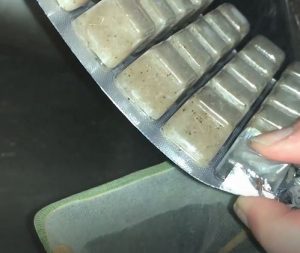
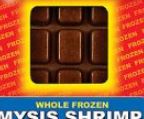
- Avoid foods with unusual air bubbles
- Avoid packages that are not flat
- Only buy from online vendors who use dry ice to ship frozen foods
- Use frozen foods within 2 months of purchase
- Do not trust expiration dates
- Throw out any food that is accidentally thawed
Freezing seafood slows down the break down of quality and growth of bad bacteria. However, the moment frozen food begins to thaw, any bacteria that was on the food prior to freezing begin to multiply. The longer the food sits out, the faster harmful bacteria can grow. Lipids and other nutrients that you want the seahorses to gain from eating the food also begin to break down at a very fast rate. We do not thaw seafood we plan to eat for dinner on the counter (or if you do…..stop it!), and frozen fish foods need the exact same considerations. One way to safely thaw frozen mysis is to put the amount you intend to use in the refrigerator, inside a cup of chilled tank water. This allows the food to thaw slowly so it does not lose quality, and the refrigerated temperatures stop bad bacteria from taking over.
I am really bad with time management and often realize that I forgot to refrigerate food for the seahorses’ next feeding. In these situations, rinsing the mysis in a brine shrimp net by running cold water over it is better than letting the food thaw at room temperature. Rinsing the food can clean it of preservatives, additives and many unwanted little bits, but it also destroys quality somewhat. The “cool water” needs to keep the food below the temperature “danger zone” (between 40 – 140 degrees Fahrenheit), which can be difficult to determine without pulling out a thermometer. But, rinsing is always better than letting the food sit out on a counter. In these cases, just use very cool water, and feed immediately after rinsing. Frozen fish food above all else is seafood, so prepare it is if you were going to eat it yourself!
HOW SHOULD I FEED THE THAWED FROZEN FOOD TO SEAHORSES?
There are a few different methods seahorse keepers use to feed:

- Broadcast feeding
– means to toss the food into the tank and let the seahorses chase it around in the flow. A benefit to this method is that the food appears more real to the seahorses, as the flow makes it seem to move around. However, removing left over food is more difficult using this method, especially if the tank has substrate or many other places that food could get trapped and rot.




- Target feeding
– involves using something like a turkey baster (or Julian’s Thing) to feed piece by piece. This helps a keeper make sure that each piece of food is eaten and is also a good way to observe whether any seahorses are not eating as well as usual. An important note is to not chase a seahorse around a tank with a baster. If they are not eating the food, they might need more time to get used to the baster, and chasing them will just make them fearful. When I target feed seahorses, I try to keep the baster out of the seahorses direct line of vision at first. Typically, I do not even put the baster in the water, and mainly use the method more to control how fast the food is put into the system. My picky female barouri likes to look over each piece of food, to be sure it meets her approval and still contains eyes and other parts that make it look alive. She will not eat food that is just sitting on the ground, or blows by her too quickly. Using the baster allows me to put in a few pieces of mysis at a time, and keep better track of any that she decides are not good enough to eat.
- This is also helpful in an aquarium with more aggressive tank mates. Target, or even hand feeding seahorses ensures that they do not have to compete just to eat. Even if the “more aggressive” eaters are other seahorses, I have many times broadcast or station fed the tank as a whole, but target fed specific seahorses who were merely more shy. Hand feeding can even be accomplished when the seahorses learn to trust completely, but using equipment is better to avoid adding hand oils to the tank.

- Feeding station
– Seahorses can easily be trained to eat from a feeding station, which helps minimize any leftovers and allows observation of any seahorses not eating. A feeding station can be purchased online, or made from any round-ish container that is saltwater safe. Patience is required to train the seahorses to eat from the dish, but they are quite smart and catch on very quickly. The container should be placed in an area of lower flow, so that the food is not immediately blown out. Using wave makers that have a feed option becomes very useful, because you can stop the highest flow in the aquarium for ten minutes, and remove any uneaten food before it turns itself back on. Once you’ve found a place to put the feeding station, use a turkey baster or Julian’s Thing to add thawed mysis to the feeding station. After 10 minutes (or before the wave maker starts back up), remove any uneaten pieces still in the container. As soon as one seahorse gets the idea and begins eating at the feeding station, the other seahorses will soon follow. One important thing to remember is that a feeding station needs to be cleaned often. I would recommend avoiding any stations that have pieces that need to stay inside the aquarium, because every piece should be cleaned to prevent build up of tiny fragments of food.

CONCLUSION
Providing the right foods and proper nutrition to seahorses should be a keepers most important goal, but it does not need to become an overwhelming task. There are many different ways to add nutrition to a seahorse’s diet, and doing things differently is not always wrong. My most difficult obstacle in writing these articles is trying to accommodate keepers at different places in their seahorse experience. The larger species (excluding dwarfs) of captive bred seahorses need 3-4 feedings of frozen mysis daily to cover their basic nutritional needs. Providing variety in the diet is important, but can be accomplished by offering other frozen foods with different nutritional profiles. Do not be intimidated by words like “culturing and “enriching”, as these are options to provide MORE nutrition, but are not required. I wanted to answer all of the questions recently asked about feeding seahorses, but a NEW SEAHORSE KEEPER should focus on providing FROZEN MYSIS that has NOT BEEN PREVIOUSLY THAWED, looks WHITE IN COLOR, and has been in the freezer for LESS THAN 2 MONTHS. This alone will keep seahorses healthy as you venture into learning about other ways to provide nutrition.
Watching the seahorses’ weight and adjusting the amount fed as they grow will ensure that they stay healthy and happy. The best method of feeding seahorses and the feeding schedule itself depend on your specific situation and set up, but the actual feeding experience can become one of the best parts of owning seahorses. As of this moment, my seahorses are dancing at the glass and begging for a treat, so I must bring this article to a close. I do hope the information has helped you, and will follow up with more information soon!
“HOW CAN I GET NEW SEAHORSES TO START EATING”? and “FEEDING SEAHORSE FRY” will be covered in the next feeding questions article, and many of these topics will be revisited in more detailed articles about the specific tasks. Any feedback and comments are welcome!
CREDITS:
[mlabook author=”Josianne Stottrup, PhD and Leslie McEvoy PhD” title=”Live Feeds in Marine Aquaculture” city=”Charlottenlund and Shetland Isles” publisher=”Blackwell Science, Ltd.” year=”2003″ medium=”Electronic book”]
[mlajournal author=”Robin J. Shields J. Gordon Bell Frederic S. Luizi Brendan Gara Niall R. Bromage John R. Sargent” title=”Natural Copepods Are Superior to Enriched Artemia Nauplii as Feed for Halibut Larvae (Hippoglossus hippoglossus) in Terms of Survival, Pigmentation and Retinal Morphology: Relation to Dietary Essential Fatty Acids” journal=”The Journal of Nutrition” volume=”129″ issue=”6″ year=”1999″ pages=”1186 – 1194″]
Patrick Schubert, Lena Vogt, Klaus Eder, Torsten Hauffe and Thomas Wilke, Effects of Feed Species and HUFA Composition on Survival and Growth of the Longsnout Seahorse (Hippocampus reidi),Frontiers in Marine Science, 3, (2016).
Piscine Energetics. “PE Mysis Frozen”. Mysis.com Web Page. http://www.mysis.com/product-category/pe-mysis-frozen
Hikari USA. “Mysis Shrimp”. Hikariusa.com Web Page. http://www.hikariusa.com/wp/diets/mysis-shrimp
Dan Underwood. “Dan’s Feed Enrichment”. Seahorsesource.com product page http://seahorsesource.com/?wpsc-product=dans-feed-artema-enrichment.
Dan Underwood. “Dan’s Feed Probiotic Enrichment”. Seahorsesource.com product page. http://seahorsesource.com/?wpsc-product=dans-feed-with-probiotics
Reed Mariculture. “Online Support Guides”. Reedmariculture.com Web Page. http://reedmariculture.com/support_online_resources.php
[mlamagazine author=”Tami Weiss” title=”Frozen Mysis Parts 1 & 2″ magazine=”Fusedjaw.com” date=”5/11/2014″ pages=”2″ medium=”Online Forum” addt=””]















